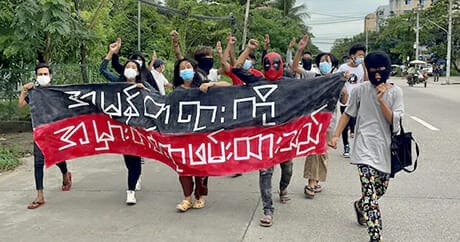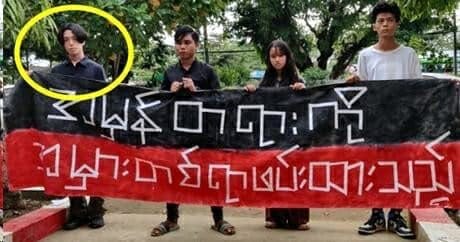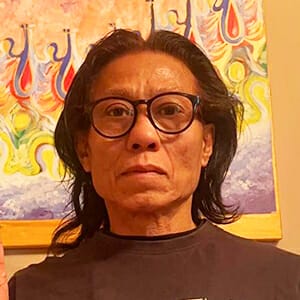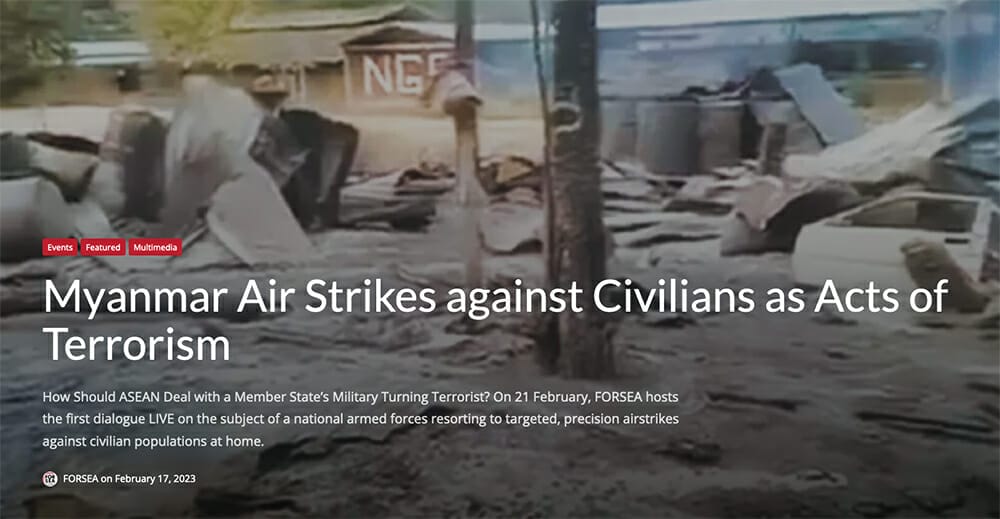On FORSEA Dialogue Series on Democratic Struggles, Toru Kobuta, the 27-year-old documentary filmmaker from Tokyo, and Ko Aung (57), founding member of the All Burma Federation of Student Unions All Burma Federation of Student Unions ((ABFSU) and a Burmese political exile in London, talked about their ordeals in the hands of Myanmar’s notorious military intelligence agents. Both of them had been put in solitary confinement in one of the Southeast Asian country’s most dreaded prisons called Insein, named after the neighbourhood in the suburb of the former capital Rangoon or Yangon. (ABFSU was originally founded in the early 1930’s as an anti-British colonial organization and re-established during the nationwide revolt against General Ne Win’s one-party military dictatorship in 1988).

Toru Kubota, a freelance documentary filmmaker from Tokyo, Japan (photo provided by Toru).
Kobuta was snatched on the streets of South Dagon, a satellite town in the expanding greater Yangon city, by undercover military agents, after filming a street protest against the universally unpopular military coup of 2021. The agents jumped off a moving van, pointed semi-automatic rifles and shoved him into the van where he was blindfolded and made to keep his head down while being driven away to an unknown location.
In what turned out to be a farcical trial, Kobuta was charged with the breach of 3 domestic laws including the ominous sounding “sedition”, “telecommunication act” and “immigration act”. He was on a tourist visa while filming the anti-coup protest. In the trial, the prosecutors presented manufactured evidence – mocked up by a police photographer during Kobuta’s detention wherein Kobuta was forced to hold the protest banner along with several Burmese protestors who were also arrested by the military intelligence agents the same day. The photo made the Japanese filmmaker look as though he were participating in the anti-coup protest as opposed to documenting the protest as a documentary filmmaker with his camera from a sidewalk (see below).

The original photo showing the protest taking place.

Toru’s position some distance away while observing and filming the protest.

The mocked up photo falsely show Toru partaking in the protest.
With a chuckle he recalled, “the Myanmar authorities informed the Embassy of Japan in Yangon that I wasn’t eating food in police detention because I didn’t like the Burmese rice. So, the Embassy sent in sushi rice!” He continued, “but I was on hunger strike demanding counsellor access”, the access he was denied for a month.
He said before he undertook the initiative to document the anti-coup protests in Yangon he imagined different risk scenarios, including getting shot – and murdered – by Myanmar security troops. Kobuta wasn’t exaggerating, a fellow Japanese journalists Kenji Nagai was shot point blank on the streets of Yangon in September 2007, during the Buddhist monks’ protests against the then military dictatorship, State Peace and Development Council or SPDC.

Ko Aung – Founding Member, the All Burma Federation of Student Unions
Ko Aung, an old comrade of the leaders of the so-called 8.8.88 Generation Group including Paw Oo (better known as Min Ko Naing) and Ko Ko Gyi, was a central executive member of the ABSDF and a leader of a radical wing known as the Red Peacock. He was arrested travelling with a group of young radicals, including the two Myanmar Air Force defectors to Pegu, an ancient seat of a Mon kingdom about 100 miles north of the then capital Yangon. As in the case of Kobuta’s trial, the military intelligence produced doctored evidence – text messages which made him appear as if he was in charge of military training of young protesters. He was tortured severely in the interrogation as the much-feared military intelligence services – then known as the Directorate of the Defence Services Intelligence (DDSI) – tried to force confessions. He was arrested 4 days after the September 1988 coup.
His mental health collapsed after sustained torture and inhuman treatment. At the time he was barely 18. In the FORSEA dialogue, Ko Aung – now 57 – became visibly emotional and re-traumatized, a sign of lasting psychological damage that the military intelligence services routinely inflict on the critics of the dictatorship. He was convicted on the main charge of “undermining state stability” in a typical farcical criminal trial, and sentenced to 7 years imprisonment with hard labour.
Neither Kobuta nor Ko Aung was allowed legal representation. Ko Aung served nearly 6 out of his 7 years imprisonment while Kobuta was fortunate to be released after 111 days, thanks to “international pressure”, as the young documentarian put it.
In the FORSEA dialogue, Ko Aung observed that the same military institution which is the main instrument of terror against the 50-million peoples of Myanmar is getting progressively worse. He offered as Exhibit A the “inflation of prison sentences”. In 1988, when he was arrested a typical prison sentence is 7 years maximum and 3 years minimum for the dissidents, activists and journalists, with some exception. But over the last 40-years the regime has used the veneer of courts and trials to lock up dissidents for 40, 50, 60 years.
As a matter of fact, the latest incarnation of the same repressive military – known as the State Administrative Council or SAC – which launched the coup against the re-elected Aung San Suu Kyi government on 1 February 2021 – has been resorting to scorch-earthed military operations against the pro-democracy and anti-coup villages in the Burmese Buddhist heartlands, burning dissidents alive and summarily executing captured resistance fighters from People’s Defence Forces, the anti-coup armed resistance organizations that mushroomed throughout virtually all townships and regions in Myanmar.
Because the SAC – led by Min Aung Hlaing and backed by Russia – is losing control over population and territories it has been launching air strikes against civilian populations suspected of opposing the military coup, including hospitals, clinics, war-refugee camps, rice warehouses, schools, churches, mosques and monasteries.
 Despite the loud calls by civil society networks across Southeast Asia to the international community to designate the SAC and its military designated “as an international terror organization,” there have been very few signs that any of the national governments and multilateral organizations including the United Nations and its technical agencies are prepared to forgo their business and other interests which accrue from their normal relations with the genocidal military regime in Naypyidaw.
Despite the loud calls by civil society networks across Southeast Asia to the international community to designate the SAC and its military designated “as an international terror organization,” there have been very few signs that any of the national governments and multilateral organizations including the United Nations and its technical agencies are prepared to forgo their business and other interests which accrue from their normal relations with the genocidal military regime in Naypyidaw.
While the United Nations has in a 3rd year in a row denies the SAC coup regime a seat at the UN General Assembly – a major indicator of the regime legitimacy – its technical agencies such as the UNICEF has been business-as-usual in Myanmar, signing contracts and making $3 million donations to the criminal military. Likewise, the United Kingdom has allowed the coup regime to take control of Myanmar Embassy in London while the pro-democracy Ambassador Kyaw Swa Min, himself an ex-Colonel from the military intelligence, was locked out of the Embassy. The regional bloc Association of South East Asian Nations (ASEAN) is irreversibly divided over how to address the perennial crisis in Myanmar between the more liberal leaning governments in Jakarta, Putrajaya and Singapore and the categorically repressive regimes in Vietnam, Thailand, Laos and Cambodia. The credibility and relevancy of ASEAN has been severely damaged by the bloc’s complete impotence to deal with genocidal regimes in its backyard, from Khmer Rouge of 1970’s to the present-day nightmare of Myanmar military regime.
Watch the full discussion below –
東南アジアの自由と民主化の促進を目的に活動している研究機関FORSEAにて、ライブ配信「ミャンマー軍によるジャーナリストと活動家の迫害について」に参加する機会をいただいた。
FORSEAの共同設立者、マウンザーニ氏によるファシリテートの元、コアウン氏との3人でのディスカッションを行った。コウアン氏は「88年世代」の中心的な民主活動家である。当時のビルマにて、21歳の彼は民主活動を理由に逮捕され、インセイン刑務所に6年間収監された。現在、彼はイギリスにて弁護士として庇護申請者への法的援助を行う仕事を続けている。彼ら二人の著名なミャンマー人活動家に加わり、私は日本人の映像作家として、2022年にミャンマーにて拘束・投獄された経験を話した。
以下のリンクより視聴が可能だ。
(FORSEA Dialogue on Myanmar regime persecution of journalists and activists)
2022年の7月30日、ミャンマーのヤンゴンにて抗議デモの撮影をした直後、私はミャンマー軍によって拘束された。私がミャンマーに関わることになったきっかけや、ロヒンギャ民族との出会い、そして合計10年の判決を下されることになった不当な司法手続きについて話した。その過程には、軍当局が証拠写真を捏造し、私に不当な罪を被せた事実が含まれている。取り調べの際、彼らは私に抗議デモのバナーを持つように命令し、その写真を撮影することで、外国人の私が大衆を扇動したという事実をでっち上げた。また、私が過去に制作したロヒンギャ民族についての映像を彼らが発見し、電気通信法違反という新たな罪を私に被せることになったことも強調する必要がある。
10年の判決を下されながらも、わずか111日間の拘束期間ののちに解放されたのは、私が日本国籍保持者であり、国際的な圧力が機能したからに過ぎない。今もミャンマー全土で、2万人近くの市民が軍によって拘束されている。不当に拘束・拷問され、殺害された者も多くいる。
今年の5月、フォトジャーナリストのサイゾータイク氏(Sai Zaw Thaike)は、サイクロン・モカが及ぼした被害の状況を記録していたことを理由に逮捕され、20年の判決を下されている。軍による報道の弾圧は苛烈さを増しており、こういった事例は氷山の一角に過ぎない。
解放された者として、声を奪われたジャーナリストたちのために自分がやるべきことを考えた。2021年のミャンマーにて投獄・解放されたジャーナリストの北角裕樹氏と中心となって、ドキュ・アッタンDocu Athanというプロジェクトを開始した。Docu Athanでは、ミャンマー人のジャーナリスト/映像作家たちの作品を日本語・英語に翻訳し、ウェブサイト上に掲載し、誰でも無料で視聴が可能かつ、それぞれのクリエイターに直接寄付することが可能である。(「1アッタン=1000JPY=5.5GPB」から寄付が可能。)アッタンAthanは、ミャンマー語で声や意見という意味の単語である。Docu Athanでは、単に金銭を支援するだけでなく、みんなで声を上げ、互いに支え合おうという思いが込められている。
マウンザーニ氏とコアウン氏との対話を通じて、世代を越えた自由への奮闘についての理解を深めるとともに、若い世代をどのようにエンパワーできるかを話し合うことができた。かつて2019年にロンドンに留学していた際、私がロヒンギャについての映像を発表しようとしていた際に最も助けてくれたのがマウンザーニ氏とコアウン氏の二人であった。4年ぶりの再会となったが、改めてミャンマーの友人たちのために活動を続けていく力を分け与えられたと思う。
Toru Kobuta

